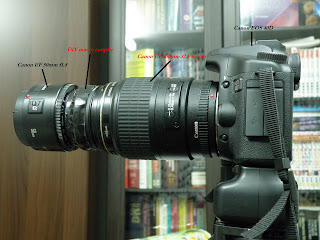I have always been very interested to get a high magnification shot of my subject... but I am too cheap to get a proper lens to do it. I know the extension tubes and closeup lenses could help... but I want something more interesting. That is... when I read about stacking of lenses, I decided to give it a try.
I have a few filters that are pretty useless, laying around my room, so I dismantle two of them and tape them up using duct tape to create a macro coupler. and then I found my trusty old 50mm f1.8 II lens lying in my dry cabinate and use it as a secondary lens.
ISO: 400
Shutter Speed: 1/4sec
Aperture: f/3.5
The above is what I have done, coupling the 100mm f2.8 macro lens to my 50mm f1.8 II lens... to form a magnification factor of 2x. Well it is not actually a high magnification macro setup, but it is pretty near. And it is darn difficult to shoot too... so taking photos of insect is quite out of the question for me, at the moment.
ISO: 250
Shutter Speed: 13 sec
Aperture: f/32
ISO: 250
Shutter Speed: 6 sec
Aperture: f/32
ISO: 250
Shutter Speed: 1.3 sec
Aperture: f/11
ISO: 250
Shutter Speed: 20 sec
Aperture: f/32
ISO: 250
Shutter Speed: 8 sec
Aperture: f/32
As you can see, I am able to achieve quite a good magnification to my subject and the lens is basically less than an inch from the subject. I purposely open a small aperture only to give it more depth of field, but still... most of the items are still blurred out.
Anyway, with this setup, it is basically quite impossible to achieve a good handhold, so a tripod is needed, and for each focus, I took around 10sec to achieve, so to shoot live insect is pretty impossible with my current skills.
So... I am hearing why stacking of two lenses would give you higher magnification then normal. There is a mathematic formula (that I found from the net).
M= Fp/Fs
M= magnification
Fp= primary lens focal length
Fs= secondary/stacked lens focal length
Thus,
M = 100mm/50mm = 2x
Note that the wider or shorter focal length of the stacked lens, the more magnification factor we will be looking at. However there is a catch here... look at how bad the vignetting is. If you use a say 28mm lens, then only a small point will be show, all others are one black void... unless your aperture is opened much wider, which will again cause some problem with the DOF... which would be paper thin.
In conclusion, I need more practice, a macro rail and more practice (did I mention more practice two times? Thats because it is very very important), external flash (off shoe and close to my subject, since my lens is very very near to the subject and so a normal flash will be blocked by the lens itself).






No comments:
Post a Comment